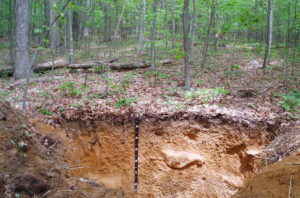1. Forest Density Impacts on Forest Growth Response to Drought

The objective of my post-doctoral research for the USGS was to understand how aridity and variability in periodic drought influence the forest density impacts on forest growth response to drought, across a climatic gradient and through time. Through integrated statistical modeling, I evaluated dendrochronological records from experimental forests maintained at varying densities, relative to aridity and drought metrics and historical forest inventory data. This research identified optimal forest management strategies to mitigate climate induced drought stress in trees across the climatic gradient of the continental US.
2. Coupled Soil Moisture – Forest Response – Climate Modeling
 Also as part of my post-doctoral research for the USGS, I used a proven ecosystem water balance model, validated with field measurements, to quantify the temporal and depth patterns of water availability during drought events in sites that represent a range of structural conditions and overarching climates. I used these detailed, site-level simulations of soil moisture conditions with more common measures of drought severity to develop metrics of ecological drought severity. These metrics are being used to evaluate interactions of water, climate, and forest response under future climate conditions for a range of forest types across North America.
Also as part of my post-doctoral research for the USGS, I used a proven ecosystem water balance model, validated with field measurements, to quantify the temporal and depth patterns of water availability during drought events in sites that represent a range of structural conditions and overarching climates. I used these detailed, site-level simulations of soil moisture conditions with more common measures of drought severity to develop metrics of ecological drought severity. These metrics are being used to evaluate interactions of water, climate, and forest response under future climate conditions for a range of forest types across North America.
3. Vegetation restoration in Grand Canyon N.P.:
 As a crew leader for the Grand Canyon National Park Vegetation Program, the objective of my work was to coordinate inventory and monitoring of managed plant species, fire effects to native and invasive vegetation surveys, and vegetation restoration projects for the Grand Canyon National Park Vegetation Program. This position required in-depth knowledge of ecosystem ecology, invasive plant ecology, plant physiology, fire ecology, and disturbance ecology theories.
As a crew leader for the Grand Canyon National Park Vegetation Program, the objective of my work was to coordinate inventory and monitoring of managed plant species, fire effects to native and invasive vegetation surveys, and vegetation restoration projects for the Grand Canyon National Park Vegetation Program. This position required in-depth knowledge of ecosystem ecology, invasive plant ecology, plant physiology, fire ecology, and disturbance ecology theories.
